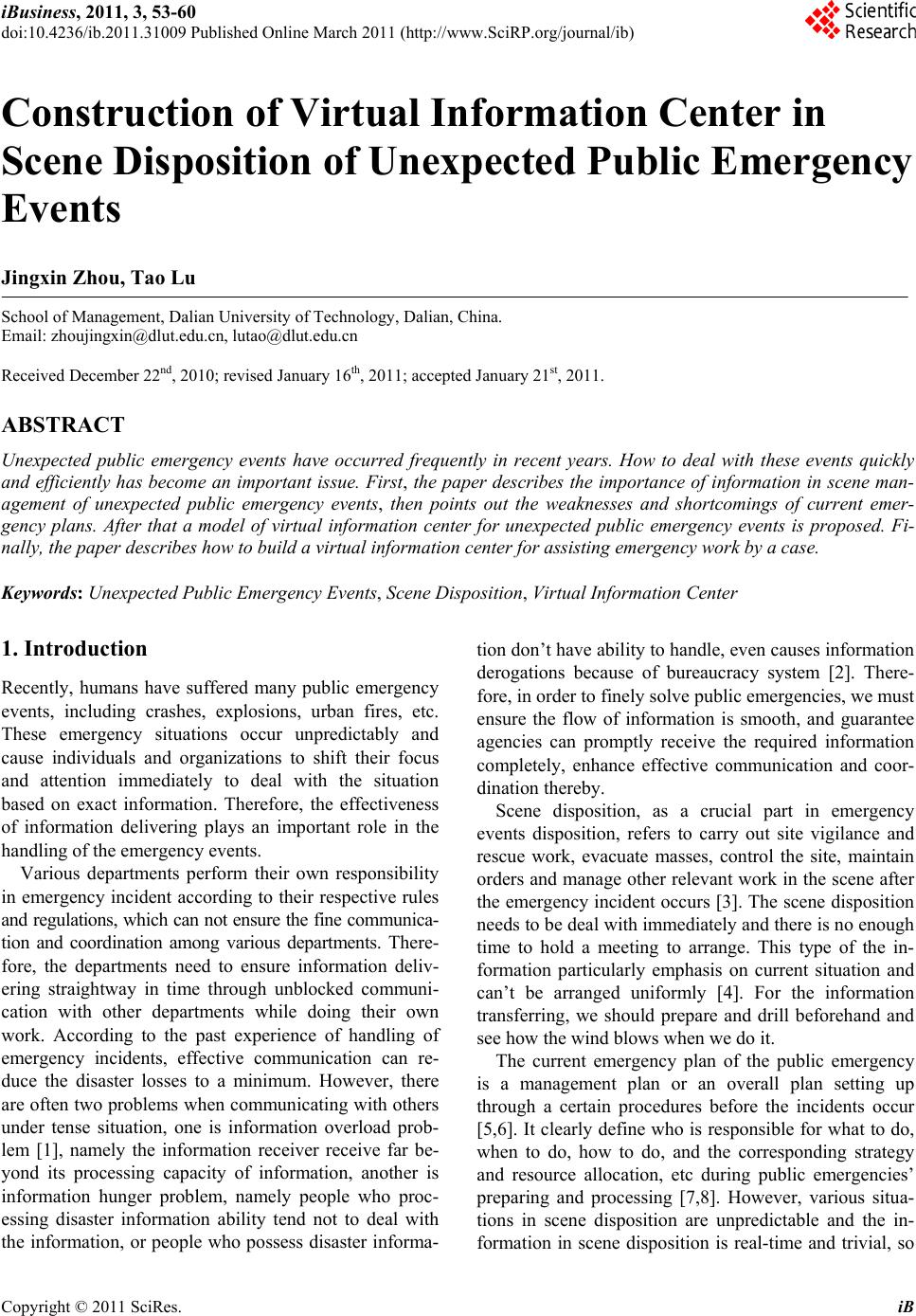 iBusiness, 2011, 3, 53-60 doi:10.4236/ib.2011.31009 Published Online March 2011 (http://www.SciRP.org/journal/ib) Copyright © 2011 SciRes. iB Construction of Virtual Information Center in Scene Disposition of Unexpected Public Emergency Events Jingxin Zhou, Tao Lu School of Management, Dalian University of Technology, Dalian, China. Email: zhoujingxin@dlut.edu.cn, lutao@dlut.edu.cn Received December 22nd, 2010; revised January 16th, 2011; accepted January 21st, 2011. ABSTRACT Unexpected public emergency events have occurred frequently in recent years. How to deal with these events quickly and efficiently has become an important issue. First, the paper describes the importance of information in scene man- agement of unexpected public emergency events, then points out the weaknesses and shortcomings of current emer- gency plans. After that a model of virtual information center for unexpected public emergency events is proposed. Fi- nally, the paper describes how to build a virtual information center for assisting emergency work by a case. Keywords: Unexpected Public Emergency Events, Scene Disposition, Virtual Information Center 1. Introduction Recently, humans have suffered many public emergency events, including crashes, explosions, urban fires, etc. These emergency situations occur unpredictably and cause individuals and organizations to shift their focus and attention immediately to deal with the situation based on exact information. Therefore, the effectiveness of information delivering plays an important role in the handling of the emergency events. Various departments perform their own responsibility in emergency incident according to their respective rules and regulations, which can not ensure the fine communi ca- tion and coordination among various departments. There- fore, the departments need to ensure information deliv- ering straightway in time through unblocked communi- cation with other departments while doing their own work. According to the past experience of handling of emergency incidents, effective communication can re- duce the disaster losses to a minimum. However, there are often two problems when communicating with others under tense situation, one is information overload prob- lem [1], namely the information receiver receive far be- yond its processing capacity of information, another is information hunger problem, namely people who proc- essing disaster information ability tend not to deal with the information, or peop le who possess disaster informa- tion don’t have ability to handle, even cau ses information derogations because of bureaucracy system [2]. There- fore, in order to finely solve public emergencies, we must ensure the flow of information is smooth, and guarantee agencies can promptly receive the required information completely, enhance effective communication and coor- dination thereby. Scene disposition, as a crucial part in emergency events disposition, refers to carry out site vigilance and rescue work, evacuate masses, control the site, maintain orders and manage other relevant work in the scene after the emergency incident occurs [3 ]. The scene disposition needs to be deal with immediately and there is no enough time to hold a meeting to arrange. This type of the in- formation particularly emphasis on current situation and can’t be arranged uniformly [4]. For the information transferring, we should prepare and drill beforehand and see how the wind blows when we do it. The current emergency plan of the public emergency is a management plan or an overall plan setting up through a certain procedures before the incidents occur [5,6]. It clearly define who is responsible for what to do, when to do, how to do, and the corresponding strategy and resource allocation, etc during public emergencies’ preparing and processing [7,8]. However, various situa- tions in scene disposition are unpredictable and the in- formation in scene disposition is real-time and trivial, so 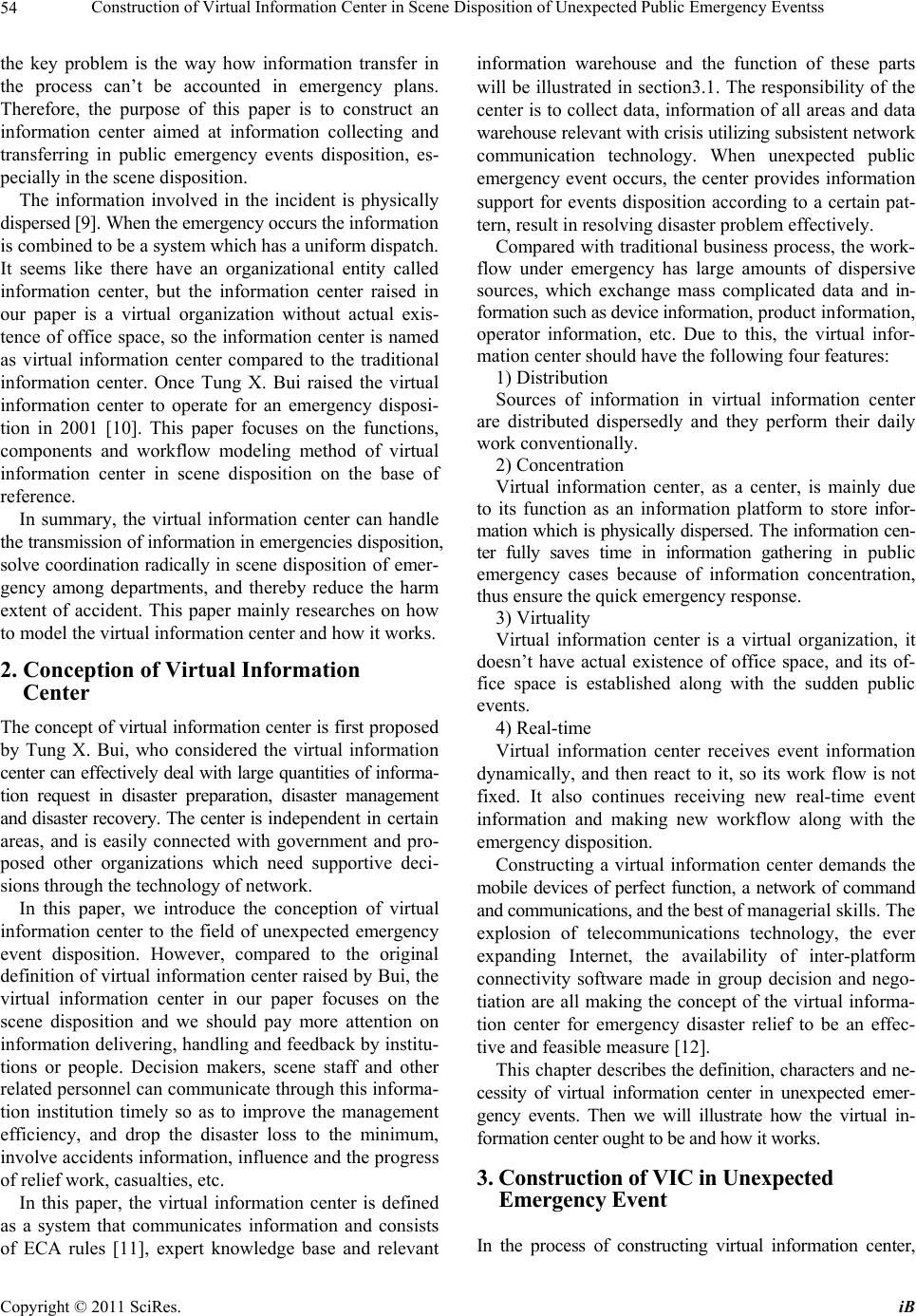 Construction of Virtual Information Center in Scene Disposition of Unexpected Public Emergency Eventss 54 the key problem is the way how information transfer in the process can’t be accounted in emergency plans. Therefore, the purpose of this paper is to construct an information center aimed at information collecting and transferring in public emergency events disposition, es- pecially in the scene disposition. The information involved in the incident is physically dispersed [9]. When the emergency occurs the information is combined to be a system which has a uniform dispatch. It seems like there have an organizational entity called information center, but the information center raised in our paper is a virtual organization without actual exis- tence of office space, so the information center is named as virtual information center compared to the traditional information center. Once Tung X. Bui raised the virtual information center to operate for an emergency disposi- tion in 2001 [10]. This paper focuses on the functions, components and workflow modeling method of virtual information center in scene disposition on the base of reference. In summary, the virtual information center can handle the transmission of information in emergencies disposition, solve coordination radically in scene disposition of emer- gency among departments, and thereby reduce the harm extent of accident. This paper mainly researches on how to model the virtual information center and how it works. 2. Conception of Virtual Information Center The concept of virtual information center is first pro pos ed by Tung X. Bui, who considered the virtual information center can effectively deal with large quantities of informa- tion request in disaster preparation, disaster management and disaster recovery. The center is independent in certain areas, and is easily connected with government and pro- posed other organizations which need supportive deci- sions through the techno logy of network. In this paper, we introduce the conception of virtual information center to the field of unexpected emergency event disposition. However, compared to the original definition of virtual information center raised by Bui, the virtual information center in our paper focuses on the scene disposition and we should pay more attention on information delivering , handling and feedb ack by institu - tions or people. Decision makers, scene staff and other related personnel can communicate through th is informa- tion institution timely so as to improve the management efficiency, and drop the disaster loss to the minimum, involve accidents information, influence and the progress of relief work, casualties, etc. In this paper, the virtual information center is defined as a system that communicates information and consists of ECA rules [11], expert knowledge base and relevant information warehouse and the function of these parts will be illustrated in section3.1. The responsibility of the center is to collect data, information of all areas and data warehouse relevant with crisis utilizing subsistent net wo rk communication technology. When unexpected public emergency event occurs, the center provides information support for events disposition according to a certain pat- tern, result in resolving disaster problem effectively. Compared with traditional busin ess process, the work- flow under emergency has large amounts of dispersive sources, which exchange mass complicated data and in- formation such as device in formation, product information, operator information, etc. Due to this, the virtual infor- mation center shou ld have the following four features: 1) Distribution Sources of information in virtual information center are distributed dispersedly and they perform their daily work convention a lly. 2) Concentration Virtual information center, as a center, is mainly due to its function as an information platform to store infor- mation which is physically dispersed . The information cen- ter fully saves time in information gathering in public emergency cases because of information concentration, thus ensure the quick emergency response. 3) Virtuality Virtual information center is a virtual organization, it doesn’t have actual existence of office space, and its of- fice space is established along with the sudden public events. 4) Real-time Virtual information center receives event information dynamically, and then react to it, so its work flow is not fixed. It also continues receiving new real-time event information and making new workflow along with the emergency disposition. Constructing a virtual information center demands the mobile devices of perfect function, a network of command and co mmunicat io ns , an d th e be st o f m anagerial skills. The explosion of telecommunications technology, the ever expanding Internet, the availability of inter-platform connectivity software made in group decision and nego- tiation are all making the concept of the virtual informa- tion center for emergency disaster relief to be an effec- tive and feasible measure [12]. Th is cha pte r d escribes the definition, characters and ne- cessity of virtual information center in unexpected emer- gency events. Then we will illustrate how the virtual in- formation center ought to be and how it works. 3. Construction of VIC in Unexpected Emergency Event In the process of constructing virtual information center, Copyright © 2011 SciRes. iB 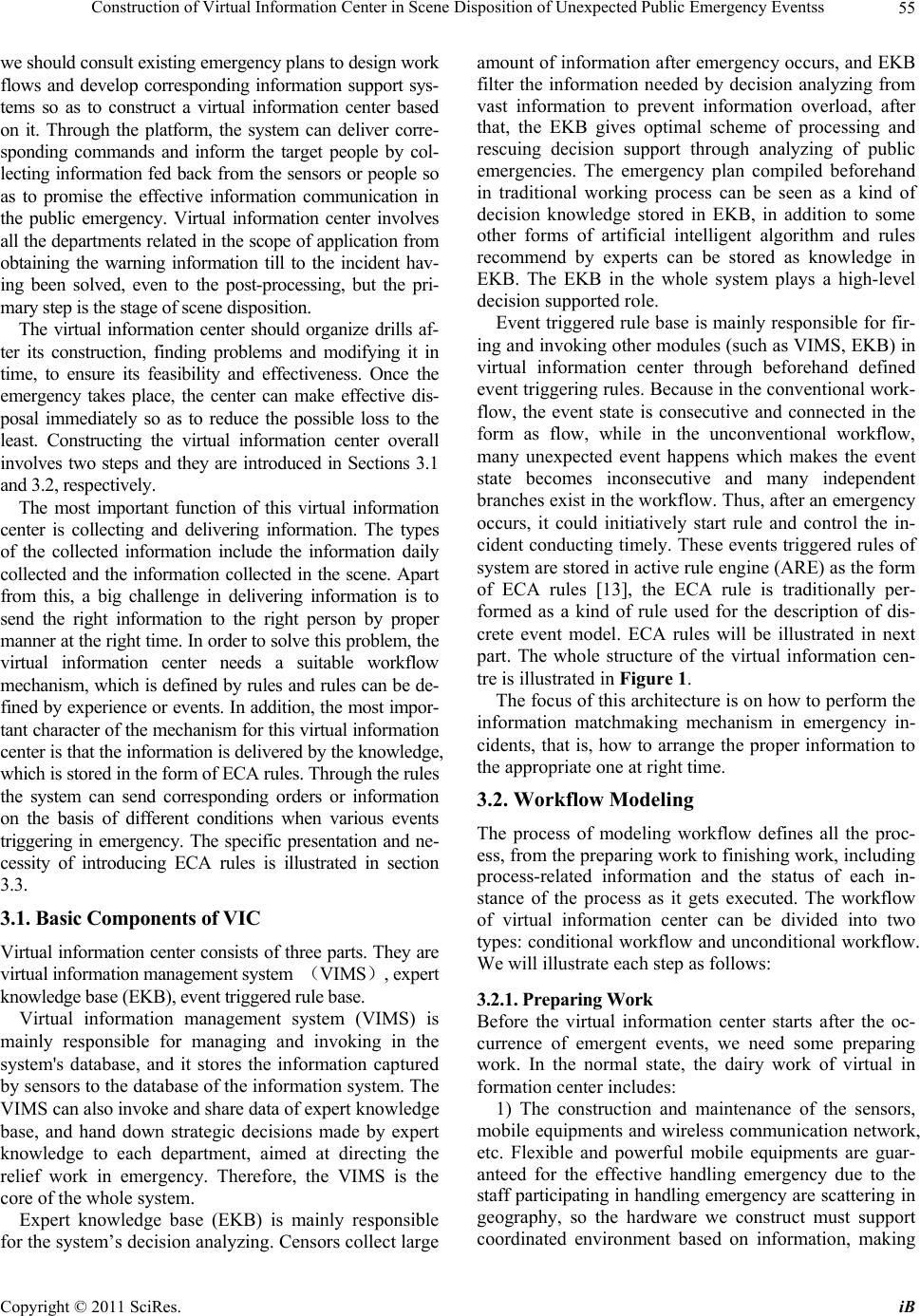 Construction of Virtual Information Center in Scene Disposition of Unexpected Public Emergency Eventss Copyright © 2011 SciRes. iB 55 we should consult existing emergency plans to design work flows and develop corresponding information support sys- tems so as to construct a virtual information center based on it. Through the platform, the system can deliver corre- sponding commands and inform the target people by col- lecting information fed back from the sensors or people so as to promise the effective information communication in the public emergency. Virtual information center involves all the departments related in the scope of ap plication from obtaining the warning information till to the incident hav- ing been solved, even to the post-processing, but the pri- mary step is the stage of scene disposition. The virtual information center should organize drills af- ter its construction, finding problems and modifying it in time, to ensure its feasibility and effectiveness. Once the emergency takes place, the center can make effective dis- posal immediately so as to reduce the possible loss to the least. Constructing the virtual information center overall involves two steps and they are introduced in Sections 3.1 and 3.2, respectively. The most important function of this virtual information center is collecting and delivering information. The types of the collected information include the information daily collected and the information collected in the scene. Apart from this, a big challenge in delivering information is to send the right information to the right person by proper manner at the right time. In order to solve this problem, the virtual information center needs a suitable workflow mechanism, which is defined by rules and rules can be de- fined by experience or events. In addition, the most impor- tant chara cter of th e mech anism fo r this v irtu al infor mation center is that the information is delivered by the knowledge, which is stored in the form of ECA rules. Through the rules the system can send corresponding orders or information on the basis of different conditions when various events triggering in emergency. The specific presentation and ne- cessity of introducing ECA rules is illustrated in section 3.3. 3.1. Basic Components of VIC Virtual infor mation center consists of thre e parts. They are virtual informati on m anagem ent system (VIMS), exp ert knowledge base (EKB), event triggered rule base. Virtual information management system (VIMS) is mainly responsible for managing and invoking in the system's database, and it stores the information captured by sensors to the database of the information system. The VIMS can also invoke and share data of expert knowledge base, and hand down strategic decisions made by expert knowledge to each department, aimed at directing the relief work in emergency. Therefore, the VIMS is the core of the whole system. Expert knowledge base (EKB) is mainly responsible for the system’s decision analyzing. Censors collect large amount of information after emergency occurs, and EKB filter the information needed by decision analyzing from vast information to prevent information overload, after that, the EKB gives optimal scheme of processing and rescuing decision support through analyzing of public emergencies. The emergency plan compiled beforehand in traditional working process can be seen as a kind of decision knowledge stored in EKB, in addition to some other forms of artificial intelligent algorithm and rules recommend by experts can be stored as knowledge in EKB. The EKB in the whole system plays a high-level decision supported role. Event triggered rule base is mainly respon sible for fir- ing and invoking other modules (such as VIMS, EKB) in virtual information center through beforehand defined event triggering rules. Because in the conventio nal work- flow, the event state is consecutive and connected in the form as flow, while in the unconventional workflow, many unexpected event happens which makes the event state becomes inconsecutive and many independent branches exist in the workflow. Thus , after an emergency occurs, it could initiatively start rule and control the in- cident conducting timely. These events triggered rules of system are stored in active rule engine (ARE) as the form of ECA rules [13], the ECA rule is traditionally per- formed as a kind of rule used for the description of dis- crete event model. ECA rules will be illustrated in next part. The whole structure of the virtual information cen- tre is illustrated in Figure 1. The focus of this architecture is on how to perform the information matchmaking mechanism in emergency in- cidents, that is, how to arrange the proper information to the appropriate one at right time. 3.2. Workflow Modeling The process of modeling workflow defines all the proc- ess, from the preparing work to finishing work, including process-related information and the status of each in- stance of the process as it gets executed. The workflow of virtual information center can be divided into two types: conditional workflow and un conditional workflow. We will illustrate each step as follows: 3.2.1. Preparing Work Before the virtual information center starts after the oc- currence of emergent events, we need some preparing work. In the normal state, the dairy work of virtual in formation center includes: 1) The construction and maintenance of the sensors, mobile equipments and wireless communication network, etc. Flexible and powerful mobile equipments are guar- anteed for the effective handling emergency due to the staff participating in handling emergency are scat terin g in geography, so the hardware we construct must support coordinated environment based on information, making 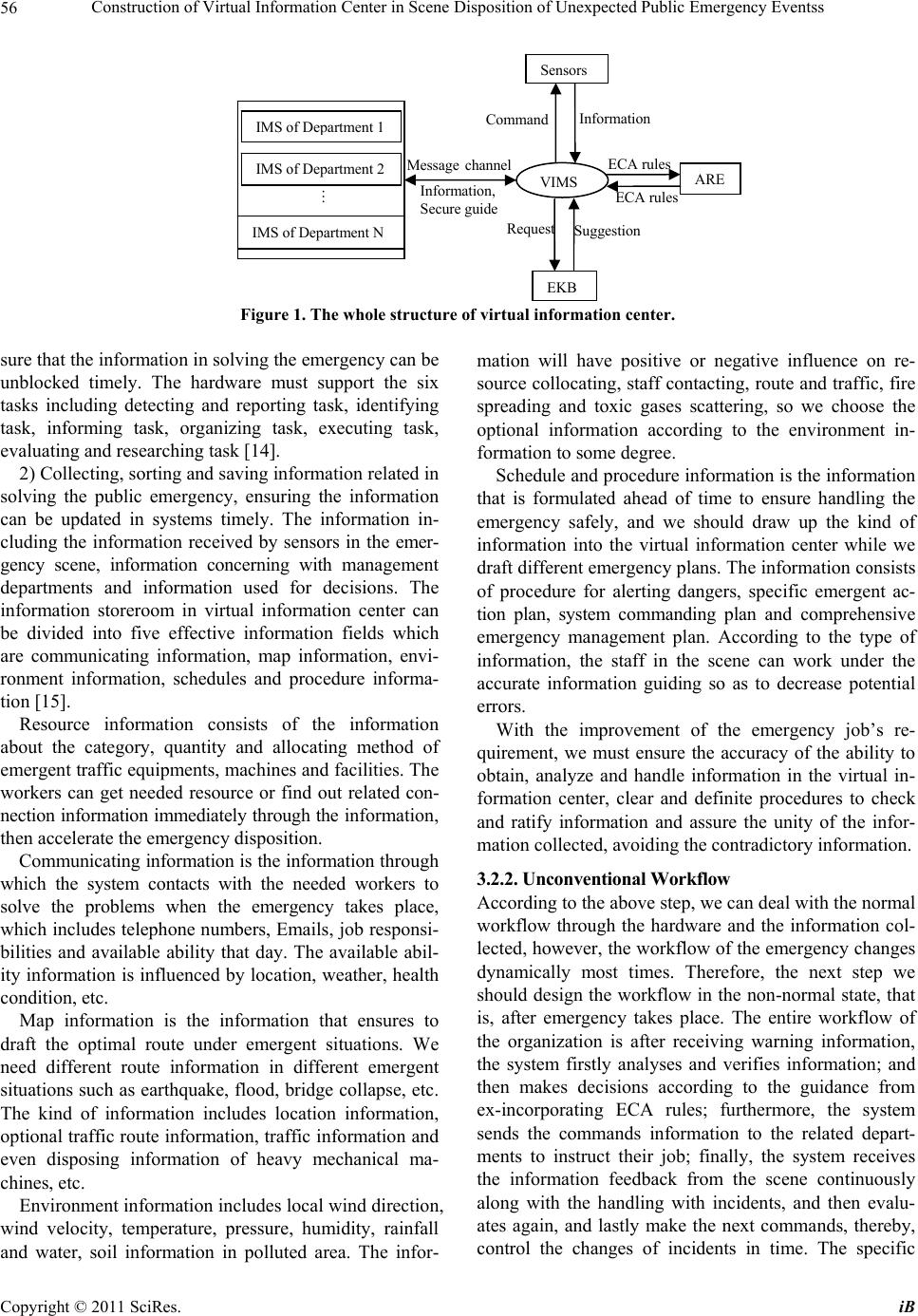 Construction of Virtual Information Center in Scene Disposition of Unexpected Public Emergency Eventss 56 Figure 1. The whole structure of virtual information center. sure that the information in solving the emergency can be unblocked timely. The hardware must support the six tasks including detecting and reporting task, identifying task, informing task, organizing task, executing task, evaluating and researching task [14]. 2) Collecting, sorting and saving information related in solving the public emergency, ensuring the information can be updated in systems timely. The information in- cluding the information received by sensors in the emer- gency scene, information concerning with management departments and information used for decisions. The information storeroom in virtual information center can be divided into five effective information fields which are communicating information, map information, envi- ronment information, schedules and procedure informa- tion [15] . Resource information consists of the information about the category, quantity and allocating method of emergent traffic equipments, machines and facilities. The workers can get needed resource or find out related con- nection information immediately through the inf ormati on, then accelerate the emergency disposition. Communicating information is the information through which the system contacts with the needed workers to solve the problems when the emergency takes place, which includes telephon e numbers, Emails, job responsi- bilities and available ability that day. The available abil- ity information is influenced by location, weather, health condition, etc. Map information is the information that ensures to draft the optimal route under emergent situations. We need different route information in different emergent situations such as earthquake, flood, bridge collapse, etc. The kind of information includes location information, optional traffic route informatio n, traffic information and even disposing information of heavy mechanical ma- chines, etc. Environment information includes local wind direction, wind velocity, temperature, pressure, humidity, rainfall and water, soil information in polluted area. The infor- mation will have positive or negative influence on re- source collocating, staff contacting, route and traffic, fire spreading and toxic gases scattering, so we choose the optional information according to the environment in- formation to some degree. Schedule and procedure information is the information that is formulated ahead of time to ensure handling the emergency safely, and we should draw up the kind of information into the virtual information center while we draft different emergency plans. The information consists of procedure for alerting dangers, specific emergent ac- tion plan, system commanding plan and comprehensive emergency management plan. According to the type of information, the staff in the scene can work under the accurate information guiding so as to decrease potential errors. With the improvement of the emergency job’s re- quirement, we must ensure the accuracy of the ability to obtain, analyze and handle information in the virtual in- formation center, clear and definite procedures to check and ratify information and assure the unity of the infor- mation collected, avoiding the contradictory information. 3.2.2. Unconventional Workflow According to the above step, we can deal with the normal workflow through the hardware and the information col- lected, however, the workflow of the emergency changes dynamically most times. Therefore, the next step we should design the workflow in the non-normal state, that is, after emergency takes place. The entire workflow of the organization is after receiving warning information, the system firstly analyses and verifies information; and then makes decisions according to the guidance from ex-incorporating ECA rules; furthermore, the system sends the commands information to the related depart- ments to instruct their job; finally, the system receives the information feedback from the scene continuously along with the handling with incidents, and then evalu- ates again, and lastly make the next commands, thereby, control the changes of incidents in time. The specific Message channel Information, Secure guide ECA rules Su estion Request Information Command IM … IMS of De artment 2 IMS of De artment 1 IMS of Department N EKB ECA rules ARE Copyright © 2011 SciRes. iB 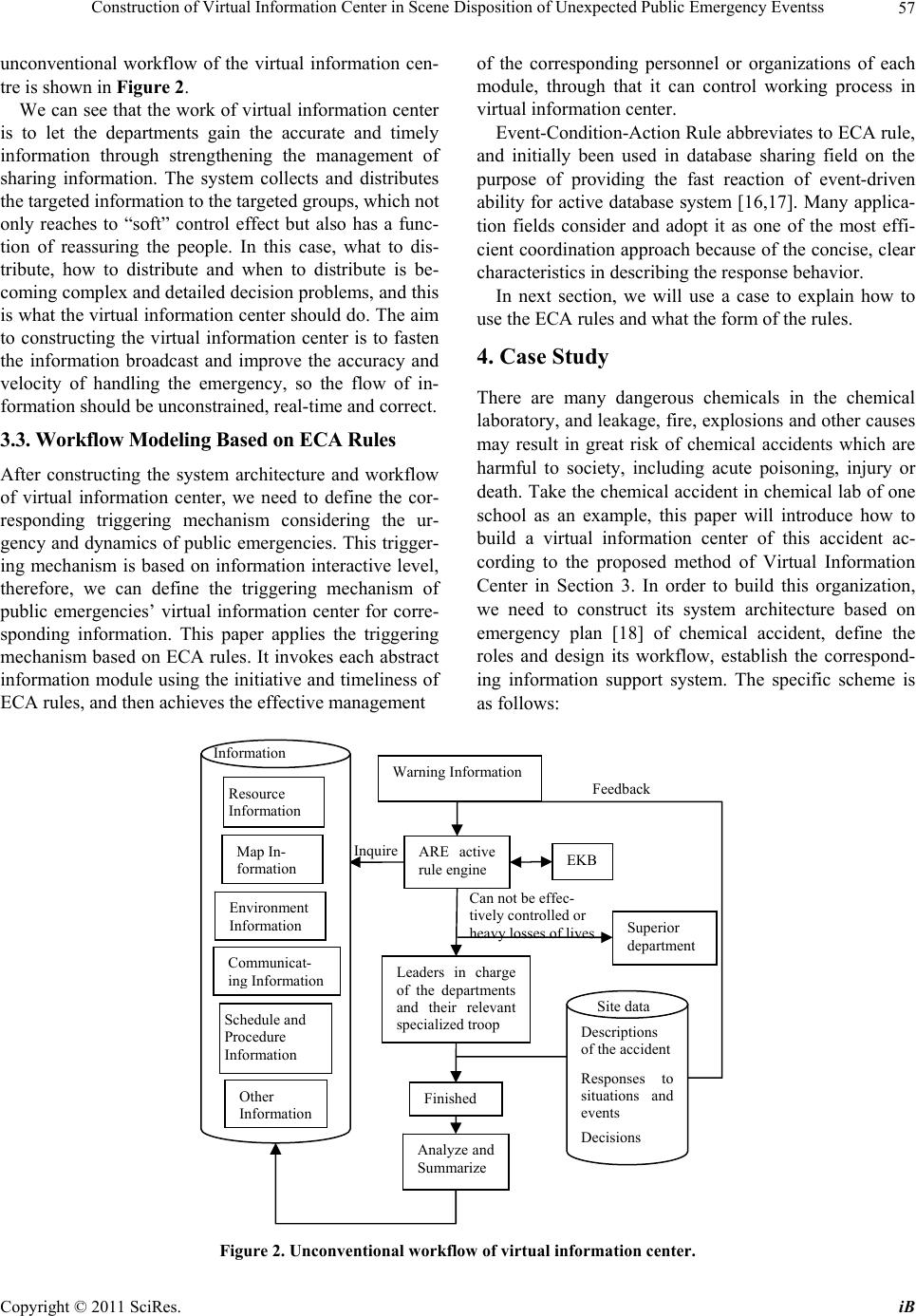 Construction of Virtual Information Center in Scene Disposition of Unexpected Public Emergency Eventss57 unconventional workflow of the virtual information cen- tre is shown in Figure 2. We can see that the work of virtual information center is to let the departments gain the accurate and timely information through strengthening the management of sharing information. The system collects and distributes the targeted info rmation to the targeted groups, which not only reaches to “soft” control effect but also has a func- tion of reassuring the people. In this case, what to dis- tribute, how to distribute and when to distribute is be- coming complex and detailed decision problems, and this is what the virtual information center should do. The aim to constructing the virtual information center is to fasten the information broadcast and improve the accuracy and velocity of handling the emergency, so the flow of in- formation should be unconstrained, real-time and correct. 3.3. Workflow Modeling Based on ECA Rules After constructing the system architecture and workflow of virtual information center, we need to define the cor- responding triggering mechanism considering the ur- gency and dynamics of public emergencies. This trigger- ing mechanism is based on information interactive level, therefore, we can define the triggering mechanism of public emergencies’ virtual information center for corre- sponding information. This paper applies the triggering mechanism based on ECA rules. It invokes each abstract information module using the initiative and timeliness of ECA rules, and then achieves the effective management of the corresponding personnel or organizations of each module, through that it can control working process in virtual information center. Event-Condition-Actio n Rule abbreviates to ECA rule, and initially been used in database sharing field on the purpose of providing the fast reaction of event-driven ability for active database system [16,17]. Many applica- tion fields consider and adopt it as one of the most effi- cient coordination approach because of the concise, clear characteristics in describing the response behavior. In next section, we will use a case to explain how to use the ECA rules and what the form of the rules. 4. Case Study There are many dangerous chemicals in the chemical laboratory, and leakage, fire, explosions and other causes may result in great risk of chemical accidents which are harmful to society, including acute poisoning, injury or death. Take the chemical accident in chemical lab of one school as an example, this paper will introduce how to build a virtual information center of this accident ac- cording to the proposed method of Virtual Information Center in Section 3. In order to build this organization, we need to construct its system architecture based on emergency plan [18] of chemical accident, define the roles and design its workflow, establish the correspond- ing information support system. The specific scheme is as follows: Figure 2. Unconventional workflow of virtual information center. Warning Information Superior department Can not be effec- tively controlled or heavy losses of lives Leaders in charge of the departments and their relevant specialized troop Analyze and Summarize Finished Descriptions of the accident Responses to situations and events Decisions Site data Inquire Feed ac EKB ARE active rule engine Information Resource Infor ation Map In- formation Environment Information Communicat- in Infor ation Schedule and Procedure Information Other Infor ation Copyright © 2011 SciRes. iB  Construction of Virtual Information Center in Scene Disposition of Unexpected Public Emergency Eventss 58 4.1. System Structure Design VIMS’ responsibilities are as follows: receiving warning information, instant information from the scene and in- struction information of emergency rescue from local government or higher education authorities; submitting information to the decision-makers timely; querying in- formation from the information base and sending mes- sages and commands to each functional department on the purpose of directing and coordinating their rescue work; sending up the situation of the accident and rescu- ing process to higher education authorities on the condi- tion that the incident can’t find effective control or result in heavy casualties. EKB: The president or the person appointed by presi- dent holds the post of chief commander while the vice-president or heads of the departments hold the post of vice-chief in decision-making. The system directs emergency disposing work real-time after receiving emergency information and in the end organizes the ac- cident investigation to update information base. Expert teams needed by EKB are made up of the experts in po- lice stations, fire brigades, health bureaus, environmental protection agencies, transportation bureaus, meteoro- logical bureaus and bureaus of civil affairs. They pro- pound emergency plan and safety measures for emer- gency rescue, and provide technical guidance for rescue work. All these emergency disposal plans and experts’ advices are stored in EKB in the form of rules or knowl- edge. IMS of depart ments: Public Security Office of School and Handan Munici- pal Bureau: they formulate pre-arranged planning of personnel evacuation and accident alert. Organization accident may endanger the personnel evacuation in area, so they must make security administration for the per- sonnel evacuation area; hey control the ambient traffic which surrounding the scene of the accident, and they inhibit cars from going into the dangerous area in order to protect the smooth flow of relief road; they involve in the accident investigation and handling. Hospital Wing and Handan Municipal Public Health Bureau: they formulate pre-arranged planning of treat- ment of injured person and ambulance emergency. They determine injured person’s professional treatment and ambulance design ated hospitals, they train corresp onding health-care professionals; they direct designated hospital to lay up corresponding medical instrumentation and first-aid medicine; they deploy medical personnel, medi- cal instrumentation and first-aid medicine of the scene, organize rescue and transfer the wounded; they count the case of casualties. Police Station and Fire Brigade: they formulate pre- arranged planning of handling hazardous chemical acci- dents. They are in charge of some tasks at the emergency scene, for example detect, vigilance, rescue, risk control, fire extinction, flood protection, export and transfer, de- contamination and cleaning. Environmental Protection Bureau: they organize the monitoring of dangerous chemical pollution incidents, and determine the composition of hazardous substances and the concentration of influential area; they warn the area that may have environmental impact for a long time, put forward controlling measures and monitoring; after the accident under control, they direct hazardous sub- stances remained at the scene to remove the environ- mental pollution; they survey major pollution incidents of dangerous chemicals and ecological damage events. Handan Municipal Communications Bureau: they specify emergency transport unit; they supervise mainte- nance of emergency vehicles, training of drivers, trans- port goods and materials and workers at the emergency scene. Handan Municipal Meteorological Bureau: they report weather information and provide corresponding technical support; they provid e weather information for emergency scene, such as wind direction, wind speed, temperature, air pressure, humidity and rainfall amount; they organize professional teams to predict the spread of fire, and the direction, speed, scope of toxic gas diffusion. Handan Municipal Civil Affairs Bureau: they organize the deployment of rescue equipment and goods and ma- terials, transfer and place disaster victims, and imple- mentation of disaster relief li f e. Information Office: they organize and coordinate pub- lication of accident news. School Affairs Office: they deal with the disposal of auxiliary field, such as placating the victims and students timely, contacting with the family of wounded . 4.2. Workflow Design In the view of the dangerous accident in school chemistry lab, the workflow of constructing virtual information center in general is as follows: 1) Constructing and maintaining the sensors, mobile devices, wireless communication network and other hardware facilities. Dangerous chemical accidents mostly have two categories including leaking accidents and fire (explosion), so sensors include automatic fire alarm and automatic alarm sensor which is distributed within the laboratory or around the laboratory to measure the hu- midity, temperature and concentration of toxic gas in air. Mobile devices include mobile telephones, interphones and other equipments which can receive information. Wireless communication network makes up of computers, a large number of microelectronic devices, precision Copyright © 2011 SciRes. iB  Construction of Virtual Information Center in Scene Disposition of Unexpected Public Emergency Eventss Copyright © 2011 SciRes. iB 59 machinery and equipment, etc. 2) Collecting, aggregating and storing the related in- formation mentioned in information base of the previous models, and ensuring to update this information timely in the system. Specific information including: Resource information includes the information of medical staffs in designated hospitals, medical equip- ments and first-aid medicines, emergency vehicles of designated emergency transport units, rescue equipments and other materials information, such as categories, amounts and ways of supplying. Staff communication information includes telephone numbers, emails, positions and available information of members in the expert teams, principals of various func- tional departments and their professional team members; it also includes the contact information and other mes- sage files of teachers, students and their parents (such as family medical histories, date of birth and so on). Cartographic information is the school’s location in- formation, optional routes of police cars, fire trucks, am- bulances, transporting vehicles, traffic information, the deployment information of heavy machineries and equipments. Environmental information is the weather information in the school location of wind direction, wind speed, temperature, atmospheric pressure, humidity, rainfall amount and the pollutant information of water bodies and soil around laboratories. Plans and procedures information concentrates all program information in alarm reporting procedures, evacuations and alerting plans, treatment and rescuing of the injured persons plans, handling hazardous chemical accidents plans and disposal of hazardous chemical pol- lution incident plans. When criminal cases or catastrophic incidents of che- micals happen, the compiling workflow of school’s vir- tual information center is: firstly, receiving warning in- formation by the sensor at the scene or the phone from teachers and students at the scene, including time, place, type, strength and damage of the accident; secondly, launching emergency disposition according to sphere, level and variation of this event immediately after con- firming and analyzing warning information; at last, transmitting warning information to the principal of cam- pus office, public security office of school, police station, fire brigade, hospital, health bureau, environmental pro- tection agency, transportation bureau, meteorological bureau and civil affairs bureau, and the heads of these departments organize professional teams and related members to the scene to work. With the processing of the incident, the system receives the information of pro- gressing, accident investigating information, casualties’ information, substance transporting information, evacua- tion information and en vironmental information fed back from emergency scene by the principals of functional departments or the members of the professional teams. The system makes command of next step after re-evalu- ating the event. After disposing the event, organizing personnel to analyze this event and composing information report to modify the pre-compiled information database in virtual information center so that they can dispose emergency work easily in future. According to the format of ECA rules, the instance described above can be represented as the set of rules which are p artly shown in Figure 3 . Each rule, when the condition is satisfied, will execute an ac- tion. In a word, the virtual information center proposed in this paper can ensure the decision-makers and expert groups to receive feedback information from scene im- mediately as soon as the chemistry lab accidents happen. We can also send the order and message to the relative target people through virtual information center so that they can take appropriate action in qu ick respon se. In th is way, we can guarantee the efficiency of scene disposition in chemical laboratory accidents. 5. Conclusions In emergency management, the information is a bridge to link each department and the steps within each depart- ment. To make sure that dealing with emergency is ef- fective during a given period of time, we must ensure the On extEvent(sensor1.tempeture > 80) and extEvent(sensor 2.alarm = on) If it is not practice Do creatExtEvent(fire(conten=‘chemical lab is on fire,hurry!’)) On extEvent(fire) If fire.reason = ‘Mg burning’ Do invokeService(EKB.request(reason of ‘Mg burning’)) On svcEvent(EKB.suggestion()) If message channel.open() Do creatextEvent(Dep1.prepare (medicine)) and creatextEvent(Dep2.prepare(secure _equipment)) Figure 3. The ECA rules of the part process in this case. 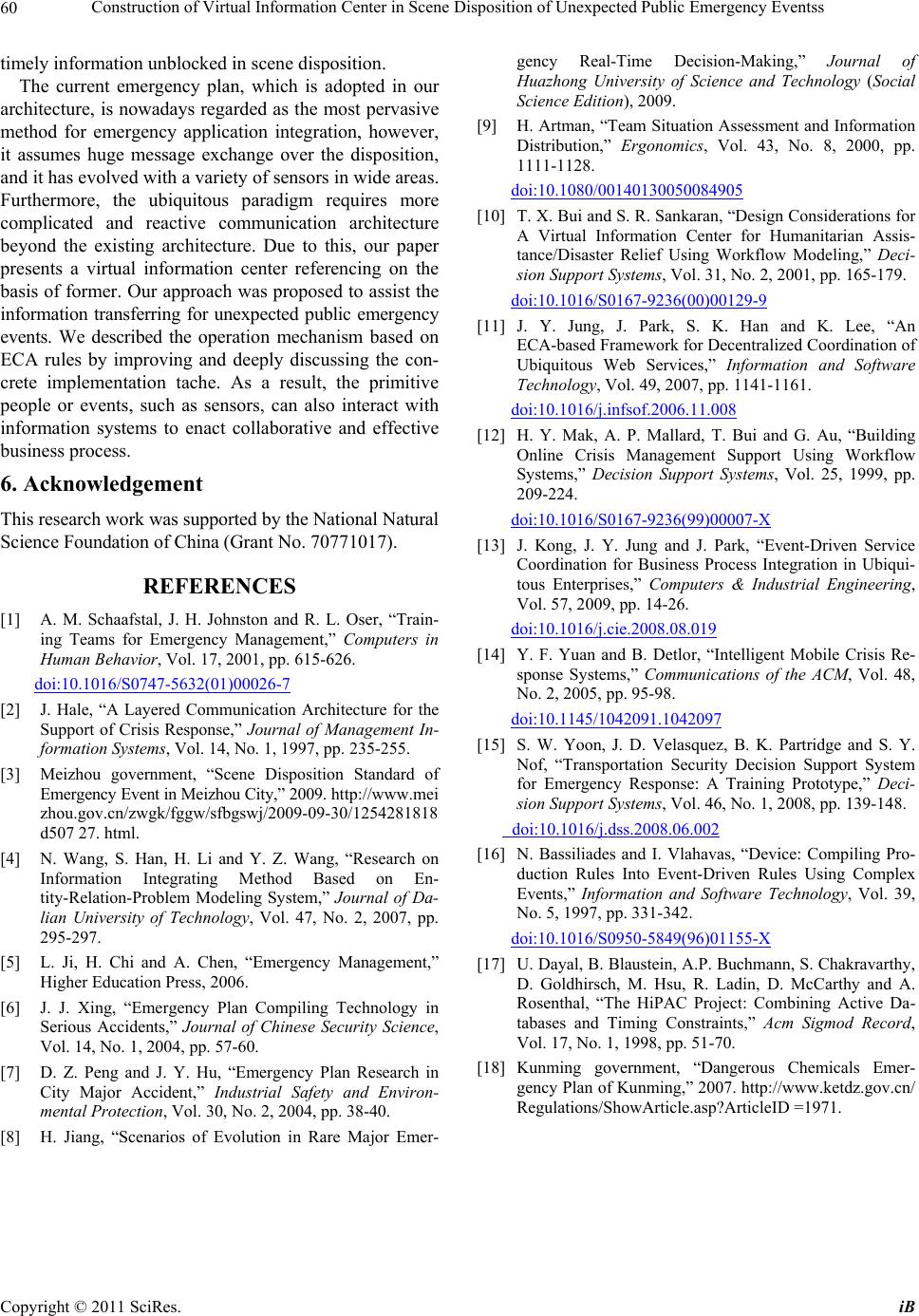 Construction of Virtual Information Center in Scene Disposition of Unexpected Public Emergency Eventss 60 timely information unblocked in scene disposition. The current emergency plan, which is adopted in our architecture, is nowadays regarded as the most pervasive method for emergency application integration, however, it assumes huge message exchange over the disposition, and it has evolved with a variety of sensors in wide areas. Furthermore, the ubiquitous paradigm requires more complicated and reactive communication architecture beyond the existing architecture. Due to this, our paper presents a virtual information center referencing on the basis of former. Our approach was proposed to assist the information transferring for unexpected public emergency events. We described the operation mechanism based on ECA rules by improving and deeply discussing the con- crete implementation tache. As a result, the primitive people or events, such as sensors, can also interact with information systems to enact collaborative and effective business process. 6. Acknowledgement This research work was supported b y the National Natural Science Founda t i on of C hi na (Grant No. 70771017). REFERENCES [1] A. M. Schaafstal, J. H. Johnston and R. L. Oser, “Train- ing Teams for Emergency Management,” Computers in Human Behavior, Vol. 17, 2001, pp. 615-626. doi:10.1016/S0747-5632(01)00026-7 [2] J. Hale, “A Layered Communication Architecture for the Support of Crisis Response,” Journal of Management In- formation Systems, Vol. 14, No. 1, 1997, pp. 235-255. [3] Meizhou government, “Scene Disposition Standard of Emergency Event in Meizhou City,” 2009. http://www.mei zhou.gov.cn/zwgk/fggw/sfbgswj/2009-09-30/1254281818 d507 27. html. [4] N. Wang, S. Han, H. Li and Y. Z. Wang, “Research on Information Integrating Method Based on En- tity-Relation-Problem Modeling System,” Journal of Da- lian University of Technology, Vol. 47, No. 2, 2007, pp. 295-297. [5] L. Ji, H. Chi and A. Chen, “Emergency Management,” Higher Education Press, 2006. [6] J. J. Xing, “Emergency Plan Compiling Technology in Serious Accidents,” Journal of Chinese Security Science, Vol. 14, No. 1, 2004, pp. 57-60. [7] D. Z. Peng and J. Y. Hu, “Emergency Plan Research in City Major Accident,” Industrial Safety and Environ- mental Protection, Vol. 30, No. 2, 2004, pp. 38-40. [8] H. Jiang, “Scenarios of Evolution in Rare Major Emer- gency Real-Time Decision-Making,” Journal of Huazhong University of Science and Technology (Social Science Edition), 2009. [9] H. Artman, “Team Situation Assessment and Information Distribution,” Ergonomics, Vol. 43, No. 8, 2000, pp. 1111-1128. doi:10.1080/00140130050084905 [10] T. X. Bui and S. R. Sankaran, “Design Considerations for A Virtual Information Center for Humanitarian Assis- tance/Disaster Relief Using Workflow Modeling,” Deci- sion Support Systems, Vol. 31, No. 2, 2001, pp. 165-179. doi:10.1016/S0167-9236(00)00129-9 [11] J. Y. Jung, J. Park, S. K. Han and K. Lee, “An ECA-based Framework for Decentralized Coordination of Ubiquitous Web Services,” Information and Software Technology, Vol. 49, 2007, pp. 1141-1161. doi:10.1016/j.infsof.2006.11.008 [12] H. Y. Mak, A. P. Mallard, T. Bui and G. Au, “Building Online Crisis Management Support Using Workflow Systems,” Decision Support Systems, Vol. 25, 1999, pp. 209-224. doi:10.1016/S0167-9236(99)00007-X [13] J. Kong, J. Y. Jung and J. Park, “Event-Driven Service Coordination for Business Process Integration in Ubiqui- tous Enterprises,” Computers & Industrial Engineering, Vol. 57, 2009, pp. 14-26. doi:10.1016/j.cie.2008.08.019 [14] Y. F. Yuan and B. Detlor, “Intelligent Mobile Crisis Re- sponse Systems,” Communications of the ACM, Vol. 48, No. 2, 2005, pp. 95-98. doi:10.1145/1042091.1042097 [15] S. W. Yoon, J. D. Velasquez, B. K. Partridge and S. Y. Nof, “Transportation Security Decision Support System for Emergency Response: A Training Prototype,” Deci- sion Support Systems, Vol. 46, No. 1, 2008, pp. 139-148. doi:10.1016/j.dss.2008.06.002 [16] N. Bassiliades and I. Vlahavas, “Device: Compiling Pro- duction Rules Into Event-Driven Rules Using Complex Events,” Information and Software Technology, Vol. 39, No. 5, 1997, pp. 331-342. doi:10.1016/S0950-5849(96)01155-X [17] U. Dayal, B. Blaustein, A.P. Buchmann, S. Chakravarthy, D. Goldhirsch, M. Hsu, R. Ladin, D. McCarthy and A. Rosenthal, “The HiPAC Project: Combining Active Da- tabases and Timing Constraints,” Acm Sigmod Record, Vol. 17, No. 1, 1998, pp. 51-70. [18] Kunming government, “Dangerous Chemicals Emer- gency Plan of Kunming,” 2007. http://www.ketdz.gov.cn/ Regulations/ShowArticle.asp?ArticleID =1971. Copyright © 2011 SciRes. iB
|